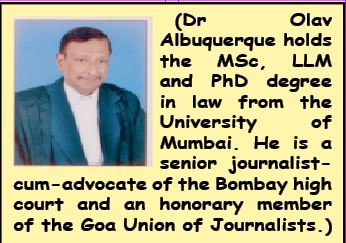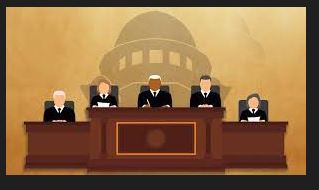By Dr Olav Albuquerque
THE Bombay high court has never had a Goan as its chief justice nor has a Goan ever gone to the Supreme Court. This is astounding for the simple reason that we have had excellent judges and we still do. Justice Gustavo F Couto was the first Goan Catholic judge who sat on the bench from 30/10/1982 to 05/03/1990. He was succeeded by Justice GD Kamat who was a judge of the high court between 29/10/1983 and 04/01/1997 to be followed by Justice Eurico Santana Da Silva who was a high court judge between 30/07/1990 and 09/05/1995.
Although Justice Kamat was the senior most judge, he was not transferred to any other high court as a chief justice. The only exception was Justice FI Rebello who was on the bench between 15/04/1995 and 02/09/2003. He was transferred as chief justice of the Allahabad high court but was not taken to the Supreme Court.
The foremost name among those who were invited to become judges of the Supreme Court is the late senior advocate Fali Nariman. The late Chief Justice of India YV Chandrachud invited him to join the judiciary but he turned down the offer. The other legal luminary was Nani Palkhivala who also turned down the offer. Both of them are not around to deny what is openly known in legal circles.
`SUPREME WHISPERS’
A FEW of these anecdotes have been recorded in “Supreme Whispers” a well-researched book by Advocate Abhinav Chandrachud, the son of the 50th Chief Justice of India, Dr Dhananajay Chandrachud. The Chandrachud name ranks alongside that of the Narimans. It is a brand in legal circles.
But leaving aside Nariman and Palkhivala, the next name that comes to mind is senior counsel Iqbal Chagla, the son of MC Chagla, well known for his autobiography, “Roses in December,” which recounts his days in the judiciary. What is not known is that his son, Iqbal Chagla, who lives at Colaba in south Mumbai, was invited to become a judge of the Supreme Court. He was one of the first few senior advocates directly invited to join the Supreme Court bench from the bar.
Iqbal Chagla turned down the offer because in his own words, “I would have to relocate to Delhi and I would have had too short a term as a Chief Justice of India” to have made much of a difference. He revealed this at a speech in the David Sassoon Library in Mumbai a few years ago. Like Chagla, there have been other senior advocates who were offered judgeship but refused the offer. Justice Riyaz Chagla of the Bombay high court is the son of Iqbal Chagla and the grandson of the late CJI MC Chagla.
JEALOUS MISTRESS, HARD TASK MASTER
SENIOR advocate Rafique Dada may be known as a judge-maker rather than a kingmaker because some of the high court judges started practicing law in his chambers. One such stalwart was Justice Jimmy Kathawala, a Parsi whose love for law may have left him a bachelor. He held court late at night in the Bombay high court, proving the adage that law is a jealous mistress and a hard task master.
The senior most advocate in Goa is Sr Advocate Surenda Dessai whose home overlooks the sea at Althinho in Panaji. He started his career in the Indian Air Force before acquiring his LLB degree from Bangalore University. Although he initially appeared for the old First Year Science examination from Chowgule College in Margao, he chose law as a career in deference to his elder brother. He too was invited to join the high court as a judge but turned down the offer because one or two of his juniors had already become judges. Celebrating 50 years as an advocate, Sr Advocate Surendra Dessai has a formidable reputation in the Goa high court.
But let us leave those who turned down offers of judgeship to dissect those who did become judges but resigned to join the bar. There have been judges like senior advocates Anil Sakhare and Yogesh K Jahagirdar who resigned together on the same date before they were confirmed to rejoin the bar. The rule is that if you resign before you are confirmed, you can practice law but if you quit after you are made a puisne (=permanent) judge after discharging judicial functions as an additional judge for two years, you cannot practice in the state where you were earlier a high court judge.
After their resignation, the next to quit the judiciary was SU Kamdar who resigned because Aurangabad was made his permanent posting, although he was allegedly assured before being sworn in that he would be retained in Mumbai. A PIL was filed in the Bombay High Court seeking that five senior advocates who were earlier sitting judges of the same high court be disallowed to practice law after quitting before they were confirmed.
After the PIL was filed, a bench comprising Justice Chandrachud and Ramesh Dhanuka, explained in their judgment that additional judges were appointed for two years to tackle the workload and there was no bar on them from returning to private practice, although there was a distinction between permanent and additional judges. Permanent judges retire after turning 62 years.
PRACTICE AFTER RETIREMENT
THERE have been many cases of high court judges after retirement, who apply to be designated as senior advocates to practice in the Supreme Court where they charge high fees to oversee drafts of Special Leave Petitions and argue these before a Supreme Court bench. This is a distinct advantage because some of the judges in the Supreme Court know these former high court judges. This is not to say that they will get any undue advantage but perhaps these Supreme Court judges will listen more intently to the lofty arguments of these former judges.
Justice Abhay Thipsay, whose brother Pravin Thipsay is a chess grandmaster, is an example of a judicial officer who rose from an additional chief metropolitan magistrate to become a sessions court judge and later a high court judge. He conducted the trial in the BEST Bakery case in which 14 persons were killed while the 21 who took part in the carnage were acquitted due to shoddy police work. He has now been designated as a senior advocate practicing in the Supreme Court.

